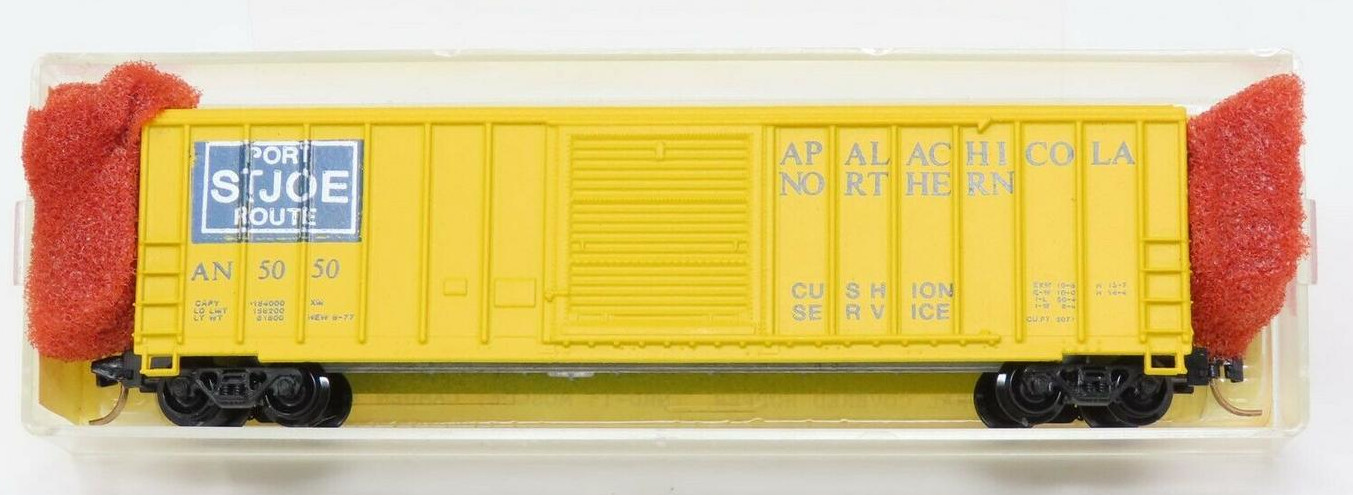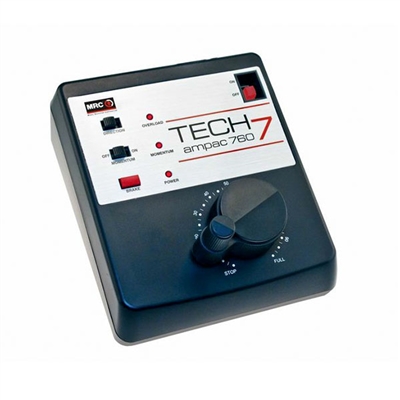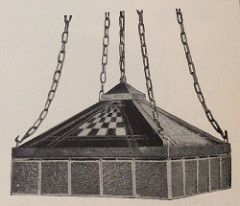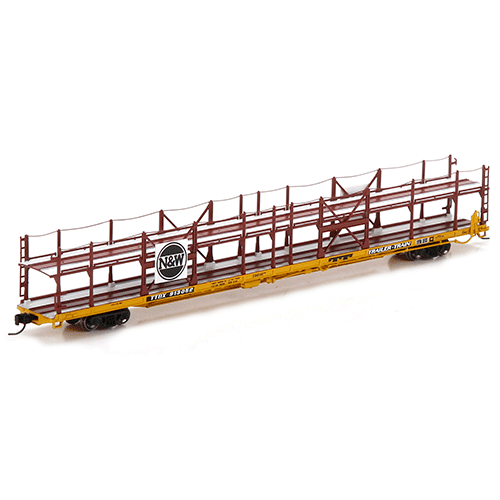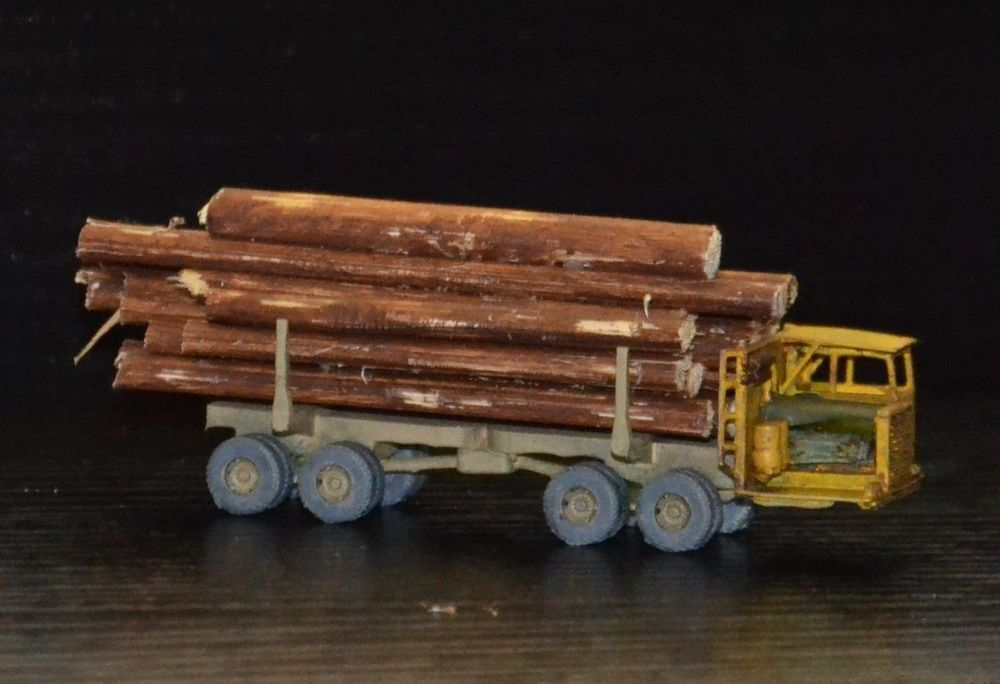N Hobby Distributing - NHD-14 - Boxcar, 50 Foot, FMC, 5347 - Apalachicola Northern - 5050
| Stock Number | NHD-14 |
| Brand | N Hobby Distributing |
| Manufacturer | Athearn |
| Body Style | MDC Boxcar 50 Foot FMC Single Door |
| Prototype Vehicle | Boxcar, 50 Foot, FMC, 5347 (Details) |
| Road or Company Name | Apalachicola Northern (Details) |
| Reporting Marks | AN |
| Road or Reporting Number | 5050 |
| Paint Color(s) | Yellow |
| Coupler Type | Rapido Hook |
| Coupler Mount | Truck-Mount |
| Wheel Type | Injection Molded Plastic |
| Wheel Profile | Small Flange (Low Profile) |
| Kit Complexity | Easy-Build |
| Kit Material(s) | Pewter Metal and Injection Molded Plastic |
| Item Category | Rolling Stock (Freight) |
| Model Type | Boxcar |
| Model Subtype | 50 Foot |
| Model Variety | FMC Single Door |
| Prototype Region | North America |
| Prototype Era | NA Era IV: 2nd Gen Diesel (1958 - 1978) |
| Scale | 1/160 |
Model Information:
Single Sliding Door Rib Side Without Roofwalk FMC. Originally designed by MDC Roundhouse. This tooling was acquired by Athearn in June of 2004 and re-released under the Athearn name. The MDC releases referred to this tooling as "FMC 50 Foot Boxcar - Single Door". Athearn refers to them as "FMC 5347 Box Car(sic)", but they are the same model.
The MDC Roundhouse releases typically came as kits (though some later releases were RTR) with an unpainted pewter underframe and truck-mounted couplers and blackened low-profile metal wheels. The Athearn releases have a nicer set of wheels (also low-profile). The Athearn models are always Ready-to-Run (RTR). The Athearn models have painted (black) underframes that are also metal (likely pewter or whatever MDC used). Athearn moved the couplers to become body-mounted and changed the coupling system from Rapido to McHenry. After inspecting them closely, I am not sure they can be swapped for MTL couplers without filing off part of the underframe, but I could be wrong. This presents a problem as McHenry couplers don't always play well with other couplers on long consists where that is a lot of force on each coupling point. The body has remained unchanged with the only detail part being the brake wheel.
The newer releases of this body style (as of 2017) market this boxcar as specifically modelling the FMC 5347 prototype.
The MDC Roundhouse releases typically came as kits (though some later releases were RTR) with an unpainted pewter underframe and truck-mounted couplers and blackened low-profile metal wheels. The Athearn releases have a nicer set of wheels (also low-profile). The Athearn models are always Ready-to-Run (RTR). The Athearn models have painted (black) underframes that are also metal (likely pewter or whatever MDC used). Athearn moved the couplers to become body-mounted and changed the coupling system from Rapido to McHenry. After inspecting them closely, I am not sure they can be swapped for MTL couplers without filing off part of the underframe, but I could be wrong. This presents a problem as McHenry couplers don't always play well with other couplers on long consists where that is a lot of force on each coupling point. The body has remained unchanged with the only detail part being the brake wheel.
The newer releases of this body style (as of 2017) market this boxcar as specifically modelling the FMC 5347 prototype.
Prototype History:
It was the mid 1970s, and the incentive per diem box car boom was just beginning. New, brightly painted box cars seemed to appear overnight. Many were lettered for various short lines. FMC (Food Machinery Corporation) was a significant builder of many of these cars. The 50’ outside post, non-terminating end box car, became the foundation for new per diem cars built in the 1970s. The 50’ FMC cars also varied in door configuration and style to better suit each customer. These cars can still be seen today at work (2017) on many ralroads.
The main difference between the 5077 cu. ft cars built by FMC vs the 5277-5347 cu. ft cars built by the same manufacturers is the overall height of the car, the smaller 5077 cars were Plate B while the larger 5277-5347 cars were Plate C.
The main difference between the 5077 cu. ft cars built by FMC vs the 5277-5347 cu. ft cars built by the same manufacturers is the overall height of the car, the smaller 5077 cars were Plate B while the larger 5277-5347 cars were Plate C.
Road Name History:
 The Apalachicola Northern Railroad has been operating in the Florida Panhandle for more than 100 years running from the Gulf Coast to the Georgia border along a system that is nearly 100 miles in length. Today, The Port St. Joe Route is known as the AN Railway and owned by the Genesee & Wyoming. Amongst railfans the Apalachicola is perhaps best known for using a rare Electro-Motive road-switcher, all three of which are still in use on the property. In recent years it has struggled to survive after the loss of paper traffic, which made up a majority of its annual carloads for decades. However, to date it has persevered and still moves a fair amount of wood-related products. Additionally, the railroad has been able to find other sources of freight in recent years to diversify its traffic base, which will hopefully allow to carry on as a successful shortline for many years.
The Apalachicola Northern Railroad has been operating in the Florida Panhandle for more than 100 years running from the Gulf Coast to the Georgia border along a system that is nearly 100 miles in length. Today, The Port St. Joe Route is known as the AN Railway and owned by the Genesee & Wyoming. Amongst railfans the Apalachicola is perhaps best known for using a rare Electro-Motive road-switcher, all three of which are still in use on the property. In recent years it has struggled to survive after the loss of paper traffic, which made up a majority of its annual carloads for decades. However, to date it has persevered and still moves a fair amount of wood-related products. Additionally, the railroad has been able to find other sources of freight in recent years to diversify its traffic base, which will hopefully allow to carry on as a successful shortline for many years.
The history of the Apalachicola Northern Railroad begins on April 7, 1903 when it was chartered to construct a route north of Apalachicola to Chattahoochee where an interchange would be made with the Atlantic Coast Line as well as the Seaboard Air Line. After roughly two years construction on the line finally began on March 21, 1905 although it took two additional years until the route was finally opened, 76.5 miles. The road's owners were soon after looking to complete the line to Port St. Joe, just west of Apalachicola along the coast. However, it fell into bankruptcy in July of the same year it opened, 1907, due to construction costs and initial lack of traffic. A year later it had exited receivership in October of 1908 and by May 10, 1910 had finally completed its long sought extension, 19.8 miles, which earned it the name as The Port St. Joe Route and gave it a total system.

The history of the Apalachicola Northern Railroad begins on April 7, 1903 when it was chartered to construct a route north of Apalachicola to Chattahoochee where an interchange would be made with the Atlantic Coast Line as well as the Seaboard Air Line. After roughly two years construction on the line finally began on March 21, 1905 although it took two additional years until the route was finally opened, 76.5 miles. The road's owners were soon after looking to complete the line to Port St. Joe, just west of Apalachicola along the coast. However, it fell into bankruptcy in July of the same year it opened, 1907, due to construction costs and initial lack of traffic. A year later it had exited receivership in October of 1908 and by May 10, 1910 had finally completed its long sought extension, 19.8 miles, which earned it the name as The Port St. Joe Route and gave it a total system.
Brand/Importer Information:
N Hobby Distributing (NHD) was based at 24 York Towne Drive, Englishtown, NJ 07726.
Item created by: Mopjunkie
on 2022-07-09 11:31:27
Last edited by: gdm on 2023-07-04 10:18:38
If you see errors or missing data in this entry, please feel free to log in and edit it. Anyone with a Gmail account can log in instantly.
Last edited by: gdm on 2023-07-04 10:18:38
If you see errors or missing data in this entry, please feel free to log in and edit it. Anyone with a Gmail account can log in instantly.


